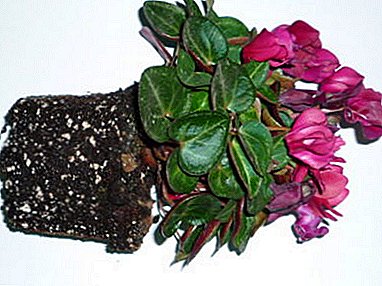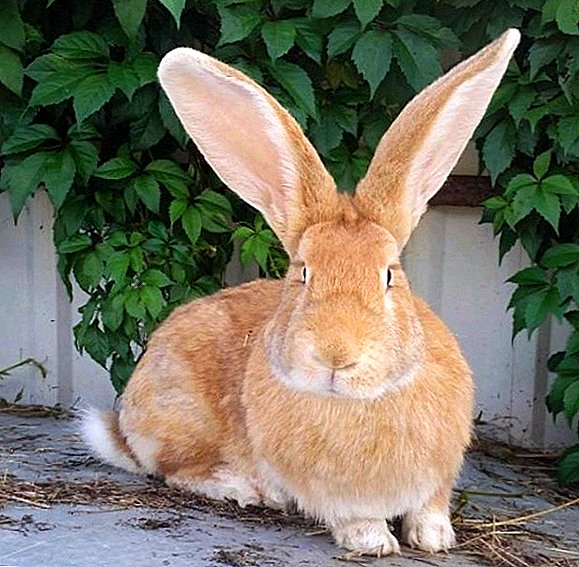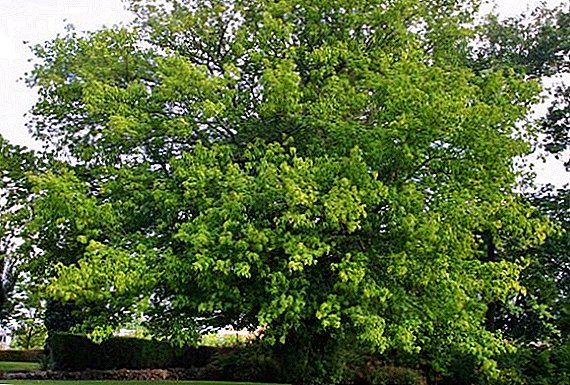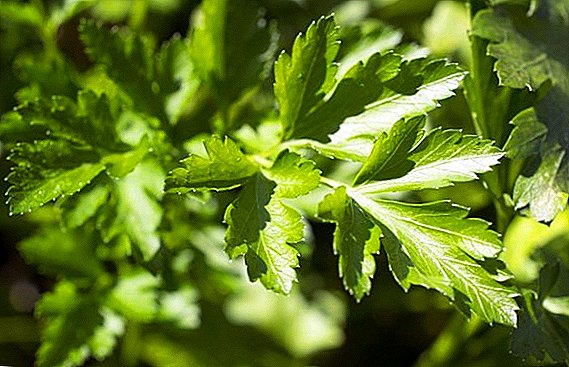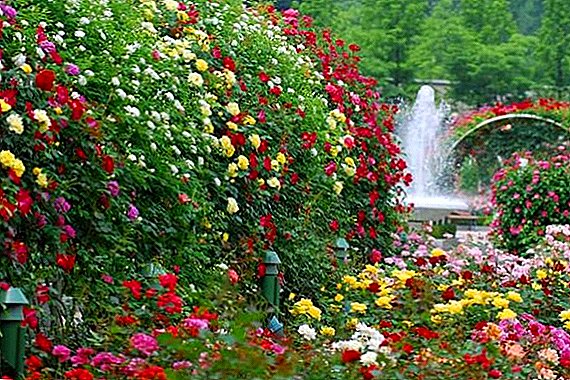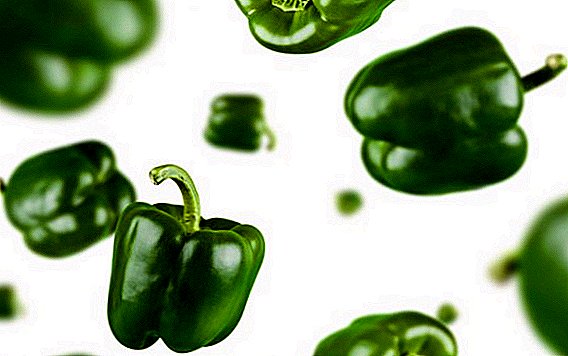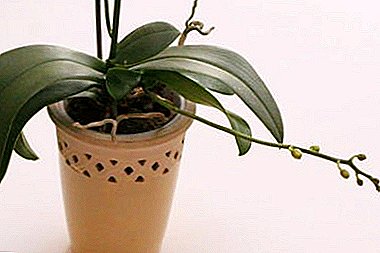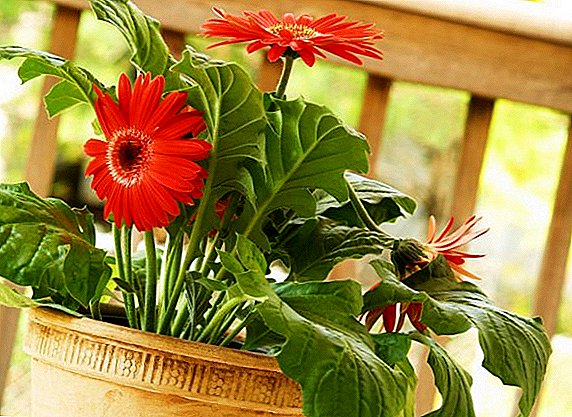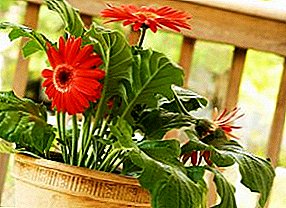 Potted gerberas are attractive for their exuberant flowering and comparative simplicity in care. Read more about how many gerbera flowers bloom and what conditions are needed for this, see below.
Potted gerberas are attractive for their exuberant flowering and comparative simplicity in care. Read more about how many gerbera flowers bloom and what conditions are needed for this, see below.
Botanical description of the flower
Gerberas belong to the herbaceous perennials of the Compositae family. As a home plant, use only one variety of stunted crops - Jameson's Gerbera. Most of the plants in the wild are found in Africa, some - in the tropics of Asia.
The room gerbera is a compact plant up to 25 cm high. The stalks are short, covered with a layer of soft pile. The leaves are elongated, pinnately dissected, up to 30 cm long, collected in a socket near the root.

Flowers solitary, looks like daisies. Among the color variations are not found only blue copies.
Flowers can be of several types:
- simple;
- terry;
- semi-double.
- tubular petals located in the center;
- reed located at the edges.
The diameter of the basket varies for different varieties from 5 to 23 cm. On the corolla, which consists of 5 tubular petals, there are 5 stamens, the anthers of which form a stamens tube. In the flower there is 1 pistil, which subsequently forms the fruit of the seed.
Did you know? Cut gerberas retain freshness for 20 days with only a small amount of water in the vase. It is enough to cover only the bottom of the vase with liquid.
Care at first after purchase
Since the acquisition, care for a gerbera consists of two techniques:
- adaptation;
- transfer to a new tank.
Adaptation
A transplant cannot be performed until the plant adapts to the conditions of the new dwelling. The plant organism undergoes severe stress during transportation, so it will take time to restore resources. 
Another goal of adaptation is quarantine, which is especially important if there are other plants in the house. Together with the new representative of the flora, you can bring pests and fungi, which is a threat to all existing plants.
On average, this period is 2-4 weeks and includes:
- a thorough examination of the plant and soil under a magnifying glass;
- isolation of a plant from other representatives of flora.
Important! Immediate transplant after purchase is permissible only in the case when the plant is bought obviously in poor condition (wilted leaves, pickled or mold-bearing soil). In other cases, aggravate the stress of the plant body is not worth it.
Transfer
Transplant after purchase is a necessary planned event aimed at improving plant immunity. Most often, plants for sale are planted in small pots, using soil, consisting mostly of peat and perlite mixture.
In order to improve the appearance, flowers are fertilized with a good portion of supplements of prolonged action (4-8 weeks). By the time of purchase all the nutrients are running out, so if you refuse this event, the flower will die in a couple of months. The postponement of such a transplant is allowed in cases where the gerbera blooms and actively develops. Then transplantation is carried out in early spring in late February - early March. On average, gerbera transplantation is carried out once every 2 years, even for young plants.
First of all, you should think about which pot to choose for the gerbera. The pot needs to be picked up not too large sizes. When choosing it is necessary to focus on the parameters of the root system, adding 3 cm. Material capacity does not matter. The main thing is that the tank was not transparent and had a sufficient number of drainage holes at the bottom.
Video: Gerbera transplant after purchase
The soil for the gerbera consists of the following elements:
- peat;
- sand;
- leaf soil;
- sphagnum moss.
Components are mixed in a ratio of 1: 1: 2: 1. As an additional element regulating humidity, you can add to the composition of the hydrogel - 3% of the total mass of the soil. Also for transplant gerbera will require drainage. In this regard, the best material - expanded clay. It helps regulate the flow of air to the root system and eliminates excess moisture.
Pre-pot and soil should be disinfected. To do this, you can use a hot solution of manganese (1 g / 1 liter of water). To avoid problems with the removal of plants from the tank, 30 minutes before transplanting, you need to water it.
Important! The composition of the soil for gerbera should not include organic compounds in the form of compost and manure. Otherwise, the risk of developing fungal diseases increases.
Step-by-step instructions for gerbera transplantation:
- Prepare the tank and lay 1-2 cm of claydite on the bottom.
- Lay a layer of soil 1-2 cm above the claydite.
- Remove the flower together with the earth lump from the pot and inspect the condition of the roots. Remove dried roots as needed. If the earthen room is too exhausted, gently wash it under running water.
- Place the plant in a new container and align it with the root collar - it should rise 2 cm above the ground surface.
- Fill the gaps with primer and slightly seal it in the lap circle. No need to water.
How to care for a home gerbera in the future
After transplantation, the plant should be slightly shaded for 5 days from direct sunlight and provide optimal microclimatic conditions for quick adaptation to the new ground.
Location selection
Gerbera belongs to the light-loving plants, but does not tolerate direct sunlight too well. The best option for the plant - southeast windowsill. The place should be protected from a draft, but at the same time assume the presence of a source of fresh air. Gerbera day must last at least 12 hours.
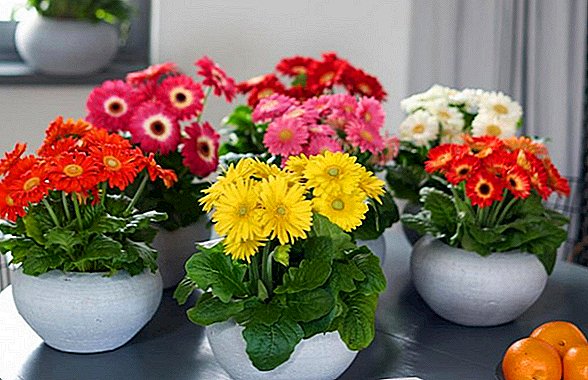
Temperature conditions
Gerbers, in addition to high-quality lighting, are demanding of heat. The lowest temperature at which plants can develop normally is + 18 ° C. At lower temperatures, the plants begin to freeze and wilt. The optimal temperature indicator for gerbera is + 20… + 25 ° С.
Watering
Selecting the mode of irrigation, it is worth considering that the plant is home to the tropics, so it is demanding on humidity. Water temperature for irrigation should not be lower than + 20 ° С. Watering is carried out on the edge of the pot so that water does not fall on the leaves, or through the pan. At the bottom irrigation water is drained after half an hour. It is best to alternate the top watering with the bottom, so as not to provoke stagnant water in certain layers of soil.
How often water gerbera depends on the temperature and humidity. It is difficult to say exactly how many times you need to water the gerbera. It is better to focus on the state of the soil. It should be constantly wet, but not turn into a swamp. The optimum indicator of soil moisture is 50%. More important is the indicator of air humidity, which is achieved by spraying.
Did you know? In the world industrial circulation of flowers, gerbera is on the 5th place in sales after roses, tulips, carnations and chrysanthemums.
Spraying
Spraying is carried out only on the sheet daily. Immediately after the procedure, you need to inspect the sheet outlet and remove excess moisture to prevent rotting. The water for this manipulation is also used warm.
Top dressing
As fertilizers for gerbera use only complex mineral supplements. If there are problems with flowering, they are replaced by compositions with a high content of potassium and phosphorus.
The vegetation period of gerberas is different from other plants. They do not have a pronounced period of rest. It coincides with the buildup of hardwood. This period falls on the middle of June and lasts until the end of August. In this period of time, nitrogen-containing feedings will be expedient. In this regard, urea fits well. 7 mg of urea is dissolved in 1 l of water. This dressing can be applied once a month at 200 ml per bush. This will be quite enough - more frequent urea introduction will provoke uncontrolled growth of the ground part to the detriment of flowering. 
In late August, gerberas begin to bloom. From this point on they begin to fertilize the flowering plants. Suitable "Florovit." 10 ml of liquid is added to 1 liter of water. Watering with fertilizer is carried out every 1-2 weeks, making 200 ml for each plant. At the end of flowering "Florovit" is not canceled, and begin to make 1 time per month.
Pruning
Home gerberas do not need pruning. When the plant ottsvetet, you need to remove the spike with sharp scissors. The cut is made as close as possible to the base.
Breeding
Considering how many gerberas live that are intended for home cultivation, which is about 5-6 years, sooner or later the bushes will have to be renewed.
Multiply the home gerbera in several ways:
- cuttings;
- division of the bush;
- seeds.
Cuttings
Cutting is carried out in the spring of the 3rd year of the plant. To carry out the manipulation, prepare the pot with the ground, as in the transplant. Then the top layer of soil is removed from the pot with the plant in order to see where the root system of the child passes. Using a sharp knife, treated with alcohol, carefully cut the stalk from the mother plant. The roots are immersed for 20 minutes in a solution of "Epin," diluted according to the instructions, and then planted the cutting in a wet substrate.
Important! Suitable for breeding cuttings with 3-4 leaves and a full root.
After planting the stalk is better to cover with transparent cellophane to create a greenhouse imitation. For 7-10 days once a day you need to air the planting, removing the bag and periodically moistening the soil, preventing it from drying out. After rooting, standard plant care is carried out.

Dividing bush
Reproduction by dividing the bush is carried out only in the 4th year of the culture's life during the spring transplant. To do this, prepare several containers, depending on the number of child parts of the bush. The soil is compiled, as for adult copies.
Read also how to grow a room gerbera on your windowsill.
After the removal of the mother plant from the soil, it is necessary to carefully remove the earthen clod and rinse the roots under running water. If the roots cannot be separated manually, they are cut through with a sharply sharpened alcohol-disinfected knife. After this, the cuts should be processed with “Fundazol” in combination with wood ash (1: 1) and plant the plants in different containers. 5-7 days after transplantation, the plants are kept under a plastic bag, as in the previous version. 
Seeds
Gerber seeds have a high germination rate. Sprout already on the 7th day after sowing. The plants propagated by seeds begin to bloom within six months from the moment of planting.
For sowing seeds prepare a mixture of leaf soil with sand in a 1: 1 ratio. Planting material is planted in spring in general oblong containers. Depth of landing - 5 mm. A distance of 10 cm is left between the seeds. The surface of the pot is covered with transparent polyethylene and set aside in a well-lit room in which the air temperature varies within + 25 ° C.
Landings are aired daily and moistened with a spray bottle as necessary. With the emergence of seedlings remove the shelter and rearrange the pot on a well-lit window sill. When 4 true leaves appear, the gerberas dive into separate small containers, focusing on the size of the root system.

Possible problems with growing
If you do not follow the rules for gerbera cultivation, you may be affected by diseases and pests. To understand how to save her, you need to understand the reasons.
The main reasons why a gerbera fades:
- Root rot - provoked by the reproduction of fungal microorganisms, which are rapidly progressing in a humid environment. An urgent transplant will help solve the problem. To do this, prepare a new substrate and pot. Flowers are removed from the old soil and washed root. After that, all affected parts of the plant are removed, then treatment is carried out with “Fundazole” in combination with wood ash. The roots are slightly dried for a couple of hours in the sun and land. After 7-10 days, top watering is performed by adding 3 drops of hydrogen peroxide to the water.
- Fusarium and Phytophthora - fungal diseases that appear dark spots on the leaves. In this case, an urgent transplant is also carried out with the removal of all the affected parts of the plant organism, washing the root and dusting with "Fundazole" with wood ash. Before using the new substrate, it must be treated with a 1% solution of Bordeaux mixture.
Did you know? To receive a bouquet of gerberas as a gift means that the giving person is sincere in his manifestations of feelings.
Before resuscitating plants, they need to be examined under a magnifying glass for the presence of pests.
Most often at home, the gerbera is amazed:
- whitefly - is removed manually by washing the leaves with a soap solution, then treatment is carried out with a solution of wood ash (1 tablespoon per 3 liters of water);
- shield - in the fight against this pest will help three-time processing "Fitoverm" according to the instructions for house plants with an interval of 14 days;
- aphid - eliminated in the same way as the whitefly.

Is it possible to transplant in open ground
Replace the home gerbera in open ground is not worth it. The fact is that the majority of specimens intended for home cultivation are low resistant to diseases and pests that progress in open ground. In addition, extra transplants will not benefit gerberas.
Home gerberas with proper care bloom for 3 months a year. Create the necessary conditions in the apartment for the full development of plants is not difficult, even not too experienced florist.


